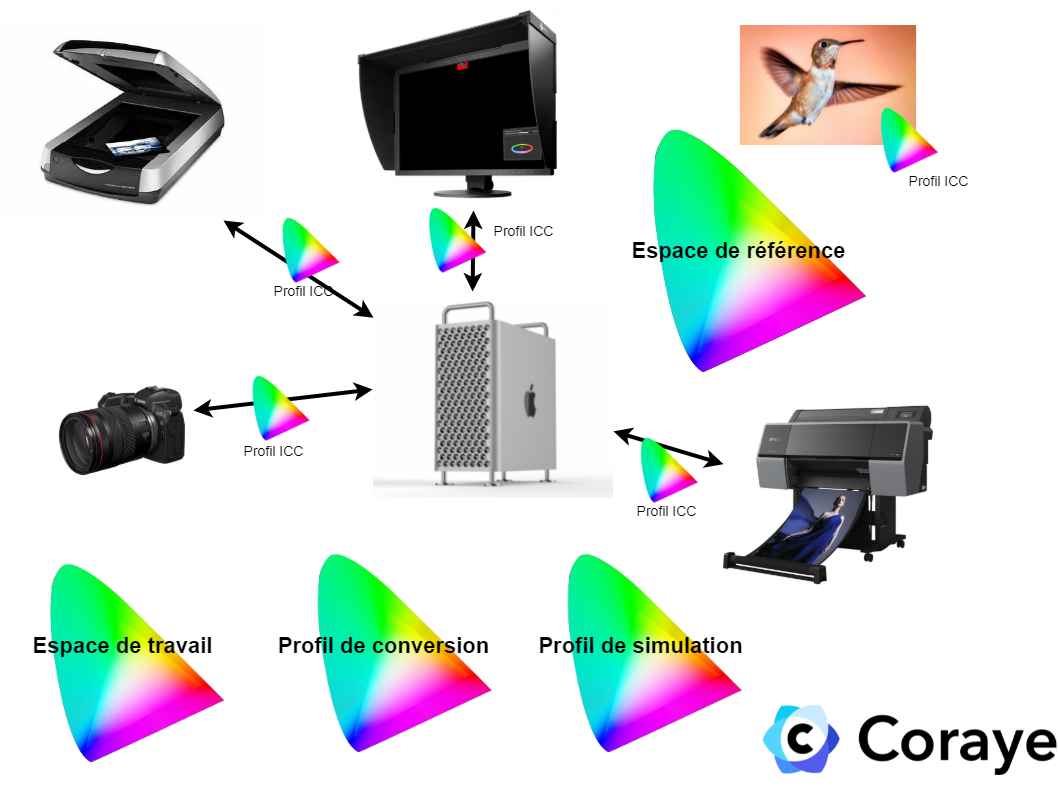ICC Profiles
An ICC ( International Color Consortium ) profile is a file with an .icc or .icm extension.
This file contains the data to convert colors from a source color space (CMYK, RGB and usually linked to a device) to an independent color space (L * a * b * or XYZ, standardized spaces covering the spectrum visible by the human eye).
It relates the coordinates of colors in the source color space to the coordinates of colors in the independent color space.
How it works
The icc profile is, therefore, a color conversion table, used by computer operating systems to correct the colors of different peripherals, but also in design software, RIPs, etc.

An ICC profile can characterize :
- a screen, a scanner, a digital camera. In this case, it will be an RGB profile;
- a printer, an offset press. In this case, it will usually be a CMYK profile.
Applications
The ICC profile allows you to know which colors are reached by the device and how it is possible:
- optimize the colorimetric rendering of the device (screen calibration, scanner calibration, paper profiles for printers, etc.)
- to calculate and visualize its gamut;
- to simulate the colorimetric rendering of the device on another for a contractual proof. A very common case is the simulation of a press on a plotter (BAT test, soft proofing)
- to harmonize the colorimetric renderings of a graphic chain between scanner, screen, plotter and press.
- convert images to switch from one color space to another (for example from RGB to CMYK)
ICC profiles have very specific functions.
For example, a screen characterization profile should not be used to convert images.
Similarly, the profile used for "calibration" of a printer's papers is not used to simulate the colors printed on a screen.
For more information, see the site: ICC Profile - Wikipedia
Location of profiles on your computers
Mac OS X
- Library> ColorSync> Profiles
- “User”> Library> ColorSync> Profiles
Windows
- Windows> System32> Spool> Drivers> Color
How to create ICC profiles
Characterizing a device or media involves measuring a range of color patches.
For a printer , we characterize a medium (paper, vinyl, tarpaulin, fabrics, etc.).
This consists in printing a test chart on the support that one wishes to characterize, then it is measured with a spectrophotometer.
For a scanner , a reference range of the IT8.7 / 2 type is scanned, then the colors of the image thus captured are compared with a text file containing the reference Lab values of the colors in the range.
For a digital camera , a reference range of Colorchecker type is photographed, then the colors of the image thus captured are compared with a text file containing the Lab values of the colors in the Colorchecker range.
| Printer | To scan | Digital camera |
 |
The icc profile thus produced contains the reference values and the measured values which will be used subsequently by the applications or the operating systems.
Coraye and ICC profiles
Coraye's Print Profiler RGB and CMYK modules allow you to create ICC profiles to allow your printing systems to reproduce colors faithfully depending on the media (paper, textile, vinyl, etc.).
It is also possible with these two modules to create simulation profiles to anticipate the results you will get when printing.
To find out more, see the chapter: Creating a profile from a standard test pattern
Coraye also uses profiles to convert measured colors, color tables, etc.
For more information, see chapter: Color converter
For more information, see the chapter: Converting color tables to make them printable


